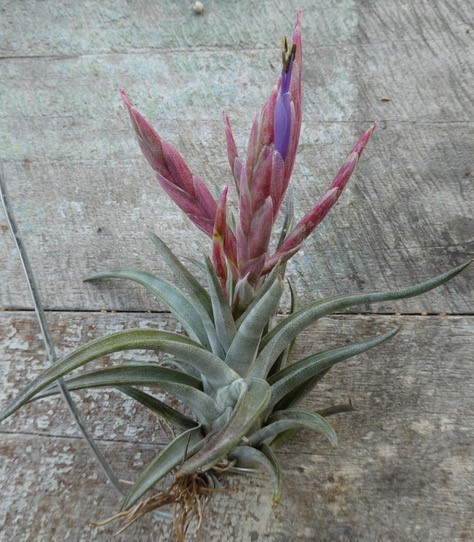

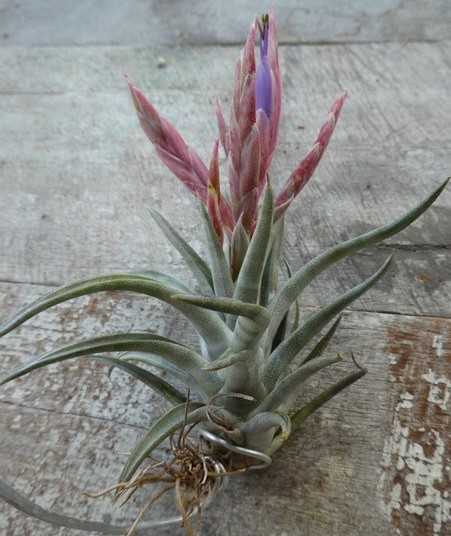
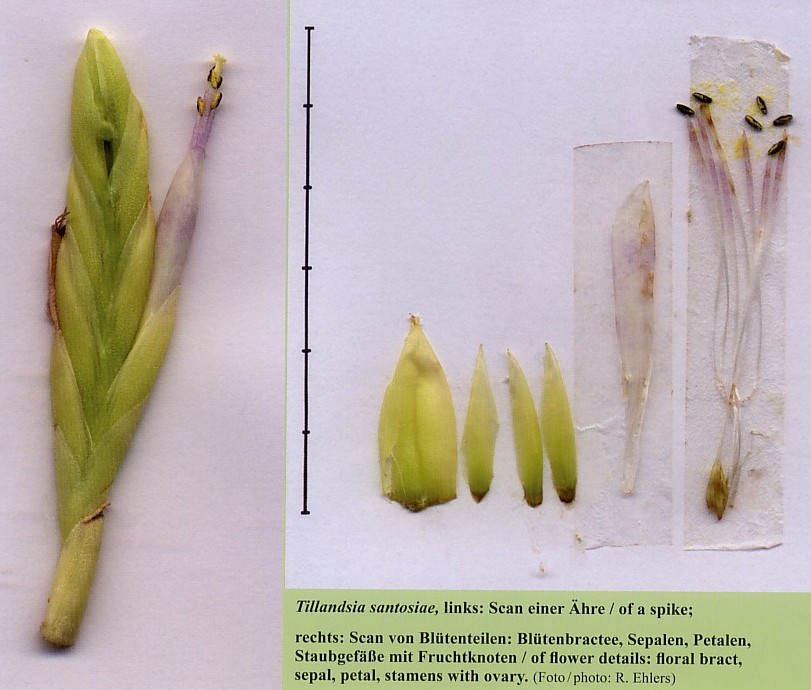
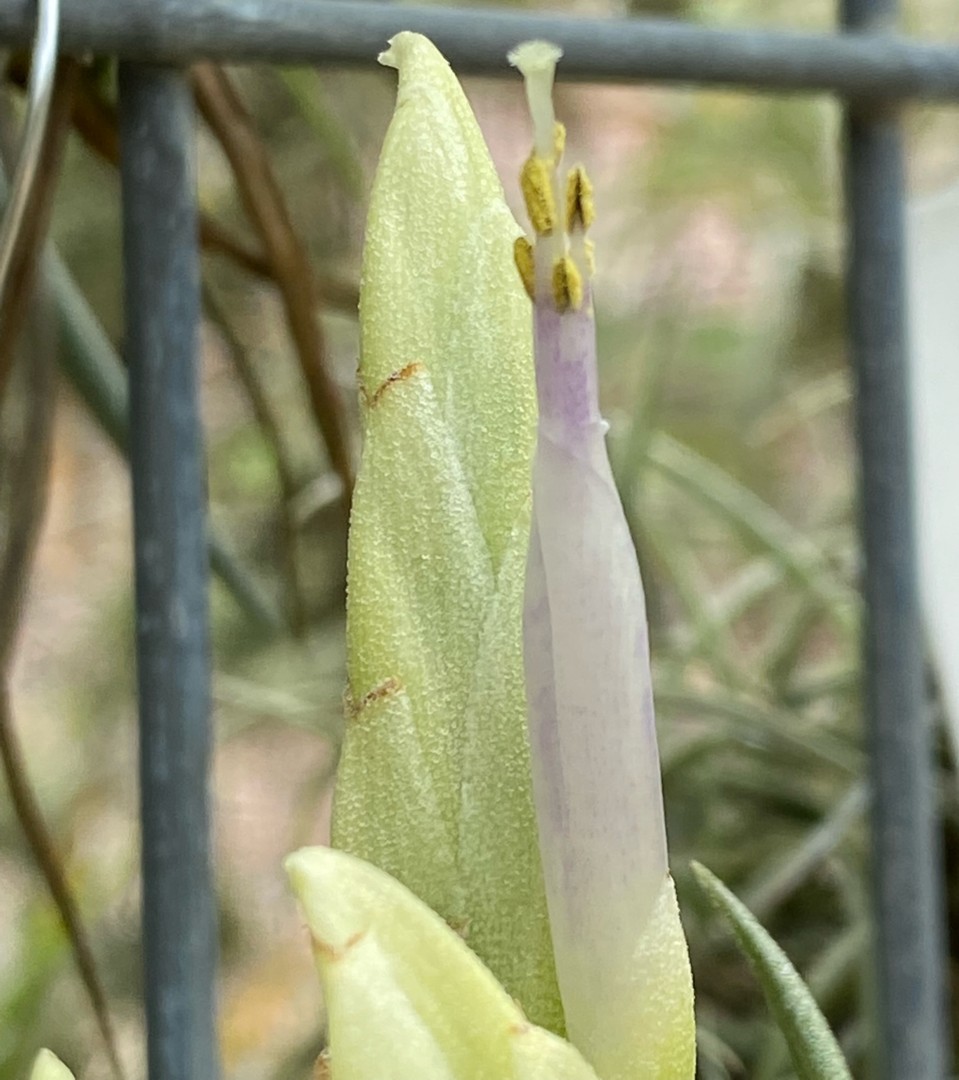
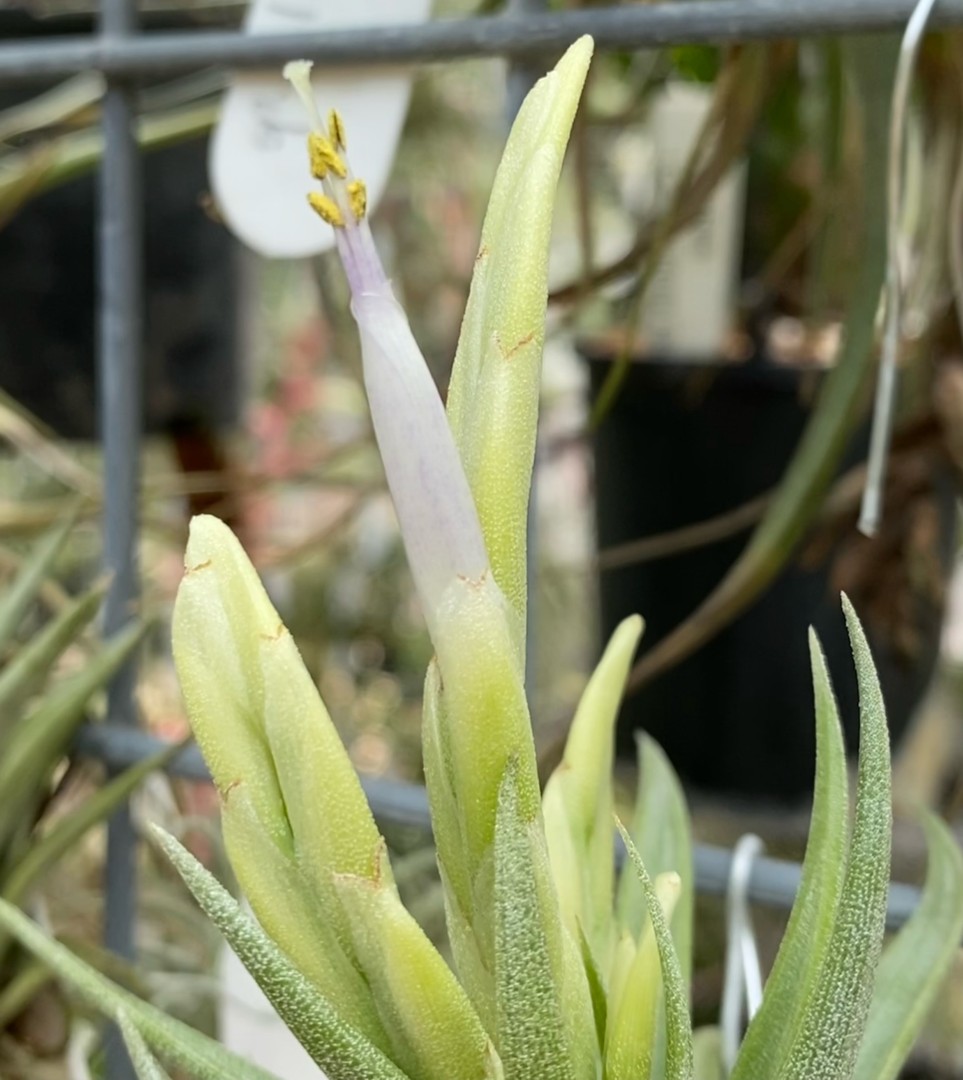
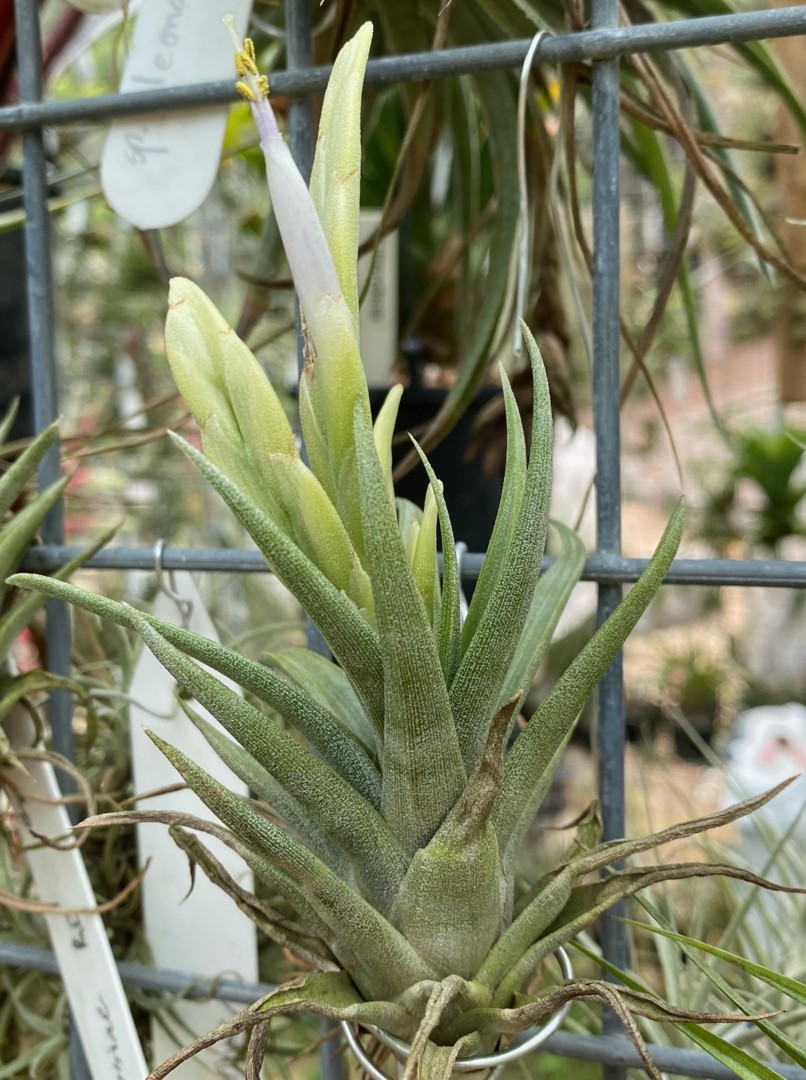


Plant gregarious on rocks, stemless or with very short rhizome at the base, up to 15 cm high, 18 cm in diam., rosette upright.
Leaves about 20, upright, soon more or less spreading, coriaceous, hard, slightly succulent, dark green, on both sides densely covered by minute grey scales;
sheaths conspicuous, 3.4 cm long, 2-2.8 cm wide, erect and appressed to each other, elliptic, light brown, slightly concave, basal 5-10 mm whitish and glabrous, above that zone on both sides covered by appressed, minute, light brown scales;
lamina 1.5 cm wide above the sheath, up to 12 cm long, basal ones reduced, triangular, canaliculate, tapering into a short, pungent apex, margins dark green, densely covered by minute grey scales.
Inflorescence erect or bent sidewards;
peduncle shorter than the rosette, 2-3 cm long, 5-6 mm in diam., round, glabrous;
peduncle bracts few, similar to inner rosette leaves;
rachis covered by the sheaths of the peduncle bracts, barely visible; fertile part exceeding the rosette, 10-15 cm long, 5 cm wide;
2-5 side branches of first order, laxly arranged, suberect; internodes between the spikes 8-10 mm; rachis glabrous, yellowish green or rose, visible;
bracts along the rachis very short, about as long as the stalk of the spikes;
spikes 4-10 cm long, up to 15 mm wide, lanceolate, complanate, stalk up to 2 cm long, distichous, at base 1-2 prophylls, 5-14 flowers each, rachis 4-angular, glabrous, nearly completely covered by floral bracts during anthesis;
floral bracts 2.2-2.4 cm long, 10-11 mm wide, elliptic, apex acute, slightly keeled, thin; margins translucent, red or yellowish, nearly glabrous, scales minute, grey.
sepals 1.8-2 cm long, 4 mm wide, lanceolate, acuminate, thin, coriaceous, glabrous, greenish yellow, nearly free, adaxial ones slightly keeled and at base 1-2 mm connate;
petals forming a narrow tube, 3.7-4 cm long, ligulate, basal part 2,5 mm wide, apical part 7 mm wide, blue or bluish white, apex obtuse, slightly reflexed;
stamens exceeding the petals, in two whorls of different length, 4.5-5 cm long, upper part 0,8 mm wide, elliptic in cross-section, narrower at base, bluish white;
anthers 2.5-3 mm long, 1 mm wide, elliptic, brown, versatile attached 1/3 above the base;
pollen egg-yolk yellow;
style 5 cm long, white;
stigma 2 mm long, 1.2 mm wide, lobes erect, slightly papillous, whitish green;
ovary 3.5-4 mm high, 5 mm in diam at the base, elliptic, light green.
Tillandsia santosiae seems to be related to T. guerreroensis Rauh (1987). The latter also dwells on rocks in a very hot area, but, to date, it is known from the type locality in Guerrero only.
Tillandsia santosiae differs from T. guerreroensis in the following characters:
Plant green, not grey;
leaves covered by appressed, minute scales, not by coarse, eccentric scales;
sheaths longer and wider;
lamina longer and above the sheaths 1.5 cm, not 0.8 cm wide;
peduncle slightly shorter;
inflorescence composed of up to 5 side-branches of first order, not simple;
spikes slightly shorter and narrower;
bracts nearly glabrous, rose or yellow, not white lepidote and lustrous dark rose;
sepals longer, only slightly keeled;
petals longer and light violet, not intensive dark violet.
Introduction
Driving from La Ventosa in Oaxaca to Tuxtla Gutierrez in Chiapas, it becomes clear why the city is called La Ventosa, the windy place: a strong wind is almost always blowing there. A tight hand must be kept on the steering wheel while driving; otherwise the strong and choppy wind will blow the car off the street. The slipstream is strongest behind an oncoming truck or when passing another car. After crossing the lowlands for some time, the mountains of the Sierra de Niltepec rise on the left hand side. Near Zanatepec, a huge massif and a very narrow canyon come into sight.
Klaus and I were fascinated by these mountains 30 years ago, but there was no path to reach the foot of the mountains. Nevertheless, we set off to find a way to the massif. Despite the landscape being flat with many fenced pastures and just an occasional hill overgrown with mostly columnar cacti, the trip was most exhausting. At barely 100 m above sea level and at a temperature of nearly 40°C, we had to cross barbed-wire fences several times. We greatly underestimated the distance, and three hours later we had only made halfway. We realised that our energy would not last and turned back, demoralised and disappointed. Passing Zanatepec in the following years, the canyon attracted us from afar, but we knew it was out of our reach.
In 2005, when I returned with Jurgen and Uli Lautner and Manfred Kretz, we wanted to try to reach the mountains. Our friend Gunther Noller had asked us to watch out for Heliocereus aurantiacus var. blomianus. Earlier, McDougal had found it in the Sierra Madre north of Zanatepec. So we tried our luck, but it took us an hour just to find a way out of the town towards the mountains. Again and again we ended up in dead-end streets, again and again we asked people on the main road, and eventually, after getting lost many times, we found a promising dirt track. Our front passenger Manfred had to open and to close countless gates. We crossed several streams and small rivers, but after two hours of driving, the mountain remained far away. From time to time, we met a farmer or a horse-rider and asked for directions. We always got a new description of how to get to the mountains. Finally, we ended up in no man's land and had to head back. We wondered how McDougal had found his way to the mountains.
In 2006, via Lydia and Gerhard Kohres, I got a report by Alfred Lau from Mexico. He and his partner Silvia Santos had found a new Tillandsia in the canyon near Zanatepec.
He reports:
"Many years ago, I saw these huge rocks left of Zanatepec, but I thought that there was no road into the canyon and that it was far away from the main road. However, 50 years ago, my father had explored the canyon, which was inhabited by a lot of monkeys. But, at that time, he was not interested in Bromeliads. Three months ago, I visited this area, accompanied by my partner Silvia Santos and my father, and we were able to reach the canyon. We saw a Tillandsia growing high in the rocks. We used our binoculars, and Silvia, a student of biology and our "expert", immediately saw that it could possibly be a new species. Unfortunately, we had no rope with us and, therefore, could not reach the plants. But, one month later, we tried again. My father remained at the base of the rocks, because the climb would have been too difficult for him and he felt a bit sick. Sylvia and I climbed to the top of the rocks. We roped down from the top a bit and were able to reach the plants. In that moment, we knew it was something new and most wonderful. Furthermore, the plant is easy to cultivate, because it grows at 250 m above sea level, in warm and humid conditions, together with a small form of T. capitata. Needless to say, we took pictures from all sides of this little beauty.
Unfortunately, it was the last time that my father, who really loved fieldwork and adventures, went out into the field with us. One week later, he died. It is a most wonderful commemoration that he was with us on the days that we found and reached this new Tillandsia.
I want to name this plant after my partner Silvia Santos, student of biology. Not many women are able to climb hills and trees like she does, being crazy about plants and doing fieldwork with such enthusiasm. She has often accompanied us on very exhausting trips."
Alfredo Lau
... and I'm very happy to fulfil this wish. I've known Alfredo Lau, Jr. for more than 35 years. As a schoolboy, he was very interested in flora and fauna. Once he guided Klaus and me to an interesting cave with countless bats in the vicinity of Fortin de las Flores, Veracruz, and showed us many interesting Tillandsias and orchids in the still untouched forests. Now the circle is closed for me.
Cultivation
I received two non-blooming plants of this new species from Lydia Kohres. In spring 2007, I discovered that one of the two had begun to flower. In summer, I had to spend a longer period of time in the hospital. My greatest worry was to miss the bloom of my T. santosiae. I instructed my friend Barbara Aichele, who is not a specialist in plants, to take pictures with her digital camera for me, especially pictures of the stamens. She kept her word. When I came home after a few weeks, there was a large picture of this plant at the front door: Welcome home. The picture even shows a fly, sitting on the inflorescence. But I was lucky, the plant developed several more flowers, allowing me to examine all the details.
The only disappointing detail was that the inflorescence showed only completely faded colours. The spikes were yellowish, whereas the pictures by Alfred Lau showed wonderful shiny red spikes. The dark blue petals turned out to be of a pale blue colour in my collection.
I contacted Lydia Kohres immediately, but she had had the same disappointing experience. She wrote to Alfred Lau to tell him that in Germany the plants showed "colourless" inflorescences, although we had had a very sunny June. He also had no clue about this. In general, Mexican species flowering here in Germany in summer show very intense colours. Tillandsia guerreroensis, as a quite similar plant, for example, shows bright red inflorescences, as shown in the picture from my collection.
Now, in May 2008, as I am writing this text, another plant is in flower. Again, the inflorescence is completely "colourless".